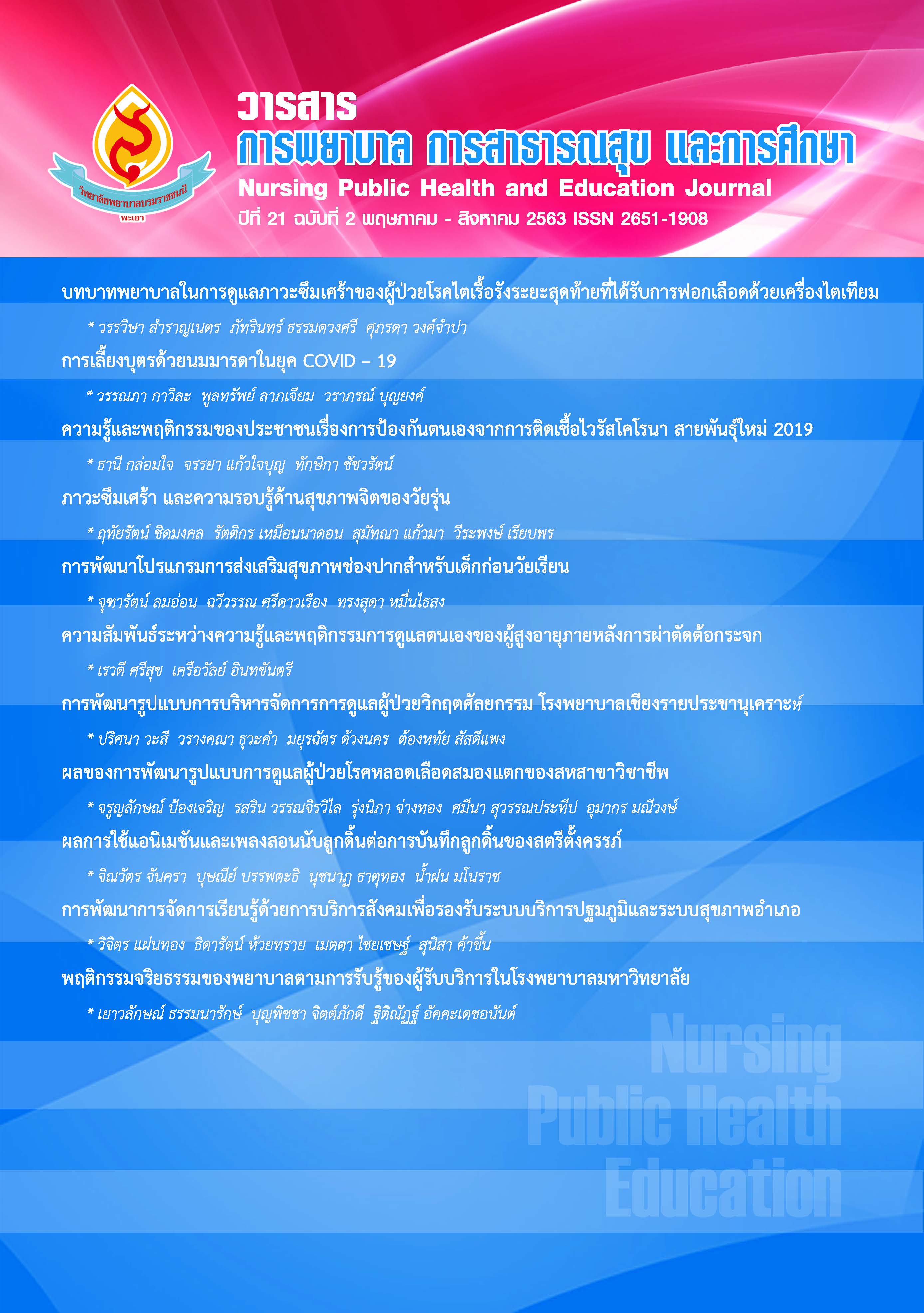ผลการใช้แอนิเมชันและเพลงสอนนับลูกดิ้นต่อการบันทึกลูกดิ้นของสตรีตั้งครรภ์
คำสำคัญ:
การนับลูกดิ้น, การบันทึกลูกดิ้น, แอนิเมชันและเพลงสอนนับลูกดิ้นบทคัดย่อ
วิจัยกึ่งทดลองแบบกลุ่มเดียวทดสอบก่อนและหลัง (one group pretest-posttest design) นี้มีวัตถุประสงค์ เพื่อศึกษา 1) เปรียบเทียบความรู้ก่อนและหลังการทดลองใช้แอนิเมชันและเพลงสอนนับลูกดิ้น 2) การบันทึกลูกดิ้นของสตรีตั้งครรภ์ และ 3) ความพึงพอใจของสตรีตั้งครรภ์หลังการใช้แอนิเมชันและเพลงสอนนับลูกดิ้น กลุ่มตัวอย่าง คือ สตรีตั้งครรภ์ที่มีอายุครรภ์ 28 สัปดาห์ขึ้นไป มาฝากครรภ์ ณ โรงพยาบาลวารินชำราบ จังหวัดอุบลราชธานี จำนวน 30 คน เครื่องมือที่ใช้ในการวิจัย ประกอบด้วย 1) แอนิเมชัน (CVI = 0.84) และเพลงสอนนับลูกดิ้น (CVI = 0.80) 2) แบบสอบถามเกี่ยวกับข้อมูลส่วนบุคคลและความพึงพอใจหลังการใช้แอนิเมชัน(CVI=0.84, alpha = 0.91) 3) แบบวัดความรู้ในการนับลูกดิ้น (CVI = 0.90, KR – 20 = 0.87) และ 4) แบบบันทึกลูกดิ้นของสตรีตั้งครรภ์ ในสมุดบันทึกสุขภาพแม่และเด็กการวิเคราะห์ข้อมูลใช้สถิติเชิงบรรยายและสถิติเชิงเปรียบเทียบ ผลการวิจัยพบว่า 1) สตรีตั้งครรภ์มีคะแนนเฉลี่ยความรู้หลังการรับชมสื่อแอนิเมชันและเพลงสอนนับลูกดิ้นสูงกว่าก่อนรับชมสื่อแอนิเมชันและเพลงสอนนับลูกดิ้นอย่างมีนัยสำคัญทางสถิติ (p<.01)2) สตรีตั้งครรภ์สามารถบันทึกลูกดิ้นได้อย่างต่อเนื่อง ร้อยละ 83.33 และ 3) ระดับความพึงพอใจของสตรีตั้งครรภ์หลังการใช้แอนิเมชันและเพลงสอนนับลูกดิ้นโดยภาพรวมอยู่ในระดับมาก มีค่าเฉลี่ยเท่ากับ 3.90 ผลการวิจัยครั้งนี้ แสดงให้เห็นว่าแอนิเมชันและเพลงสอนนับลูกดิ้นสามารถถ่ายทอดความรู้เกี่ยวกับการนับและบันทึกลูกดิ้นที่เข้าใจง่าย ทำให้สตรีตั้งครรภ์ได้รับความรู้เพิ่มขึ้นจนเกิดการรับรู้และมีแรงจูงใจที่ส่งผลให้เกิดพฤติกรรมที่เหมาะสมได้
เอกสารอ้างอิง
กัญญาพัชญ์ จาอ้าย. (2560). ผลของโปรแกรมการเรียนรู้แบบมีส่วนร่วมต่อความรู้และพฤติกรรมการนับลูกดิ้นของหญิงตั้งครรภ์ชาวไทยใหญ่ โรงพยาบาลหางดง จังหวัดเชียงใหม่.วารสารสมาคมพยาบาลแห่งประเทศไทยฯ สาขาภาคเหนือ, 23(1), 32-42.
กระทรวงสาธารณสุข. (2561). การนับลูกดิ้น. สมุดบันทึกสุขภาพแม่และเด็ก สำนักส่งเสริมสุขภาพ กรมอนามัย กระทรวงสาธารณสุข, (หน้า 20-21). กรุงเทพมหานคร: โรงพิมพ์องค์การสงเคราะห์ทหารผ่านศึก.
กองบริหารการสาธารณสุข กระทรวงสาธารณสุข. (2561). อัตราเกิดไร้ชีพ (Stillbirth Rate) ภาพรวมระดับประเทศ. สืบค้นเมื่อ 2 สิงหาคม 2562, จาก http://cmi.healtharea.net/servplan/obs/mdead?dx=3
บุญชม ศรีสะอาด. (2546). การพัฒนาหลักสูตรและการวิจัยเกี่ยวกับหลักสูตร. กรุงเทพมหานคร: สุวีริยาสาส์น.
บุญมี ภูด่านงัว. (2557). บทบาทพยาบาลในการส่งเสริมการดูแลตนเองของหญิงตั้งครรภ์ต่อการนับและบันทึกลูกดิ้น. วารสารการพยาบาลศาสตร์และสุขภาพ, 37(1), 135-146.
บุรฉัตร จันทร์แดง, เสาวลักษณ์ โกศลกิตติอัมพร และสัญญา เคณาภูมิ. (2562). ปัจจัยที่มีผลต่อการเปลี่ยนแปลงพฤติกรรม. วารสารวิชาการธรรมทรรศน์, 19(4), 235 – 244.
พีรยา ศรีผ่อง, ภัทรินทร์ กิตติบุญญาคุณ, ดุษฎลภ์ ศิริศักดิ์รัชกุล, จิตศรา แสนเรียน, วรรณนิภา ศิริกัณรัตน์, และวราภรณ์ พิมพล. (2557). การพัฒนาสื่อแอนิเมชั่นเพื่อให้ความรู้แก่ผู้ป่วยเด็กที่ติดเชื้อเอชไอวี. ศรีนครินทร์เวชสาร, 29(1), 43 – 49.
เพ็ญศรี จะนู. (2561). ผลการใช้สื่อวีดีทัศน์เพื่อเตรียมความพร้อมผู้ป่วยก่อนผ่าตัด ต่อระดับความรู้และความพึงพอใจในผู้ป่วยที่มารับบริการผ่าตัดแบบผู้ป่วยนอก ห้องผ่าตัด หู คอ จมูก โรงพยาบาลธรรมศาสตร์ เฉลิมพระเกียรติ. วารสารโรงพยาบาลธรรมศาสตร์เฉลิมพระเกียรติ, 3(3), 47 – 65.
ภควลัญช์ เพสอุน, มณีรัตน์ ธีระวิวัฒน์, และนิรัตน์ อิมามี. (2560).การพัฒนาสื่อแอนิเมชั่นเรื่องการป้องกันภาวะแทรกซ้อนของหลอดเลือดแดงบริเวณขาหนีบ ในผู้ป่วยที่ได้รับการสวนหัวใจ. วารสารสาธารณสุขศาสตร์, 47(3), 315 – 325.
วิทยาลัยอาชีวะศึกษาเชียงใหม่, (2560). การผลิตสื่อสิ่งพิมพ์. สืบค้นเมื่อ 11 ตุลาคม 2561, จาก https://sites.google.com/site/tanakorn16121997/1-4-khxdi-laea-khx-seiy-khxng-sux-sing-phimph
วิภาณี แม้นอินทร์. (2561). ประเภทของสื่อประชาสัมพันธ์. สืบค้นเมื่อ 11 ตุลาคม 2561, จาก
http://www.elfms.ssru.ac.th/wipanee_ma/file.php/1/Media_PR_Tools/Chapter_4_PR_Tools_.pdf
สุชาดา ปราบมีชัย และสมสมร เรืองวรบูรณ์. (2560). ผลของสื่อแอนิเมชั่นต่อความรู้และพฤติกรรมการดูแลตนเองของเด็กวัยเรียนโรคธาลัสซีเมีย. วารสารพยาบาลกระทรวงสาธารณสุข, 27(2), 96 – 109.
สำนักนโยบายและยุทธศาสตร์ สำนักงานปลัดกระทรวงสาธารณสุข กระทรวงสาธารณสุข. (2558). รายงานการศึกษาการตายของมารดาและทารก. สืบค้นเมื่อ 15 ตุลาคม 2561, จากhttp://ihppthaigov. net/DB/ publication/attachresearch/402/chapter1.pdf
Ashby, F.G., Valentin, V. V., & Turken, A. U. (2002). The effects of positive affect and arousal on working memory and executive attention. In: Moore S, Oaksford M, editors. Emotional cognition: from brain to behavior. Amsterdam: John Benjamins.
Johnsen, E.L., Tranel, D., Lutgendorf, S., & Adolphs, R. (2009). A neuroanatomical dissociation for emotion induced by music. Int J Psychophysiol, (72)3, 24–33.
Kolter, P. & Armstrong, G. (2006). Principles of marketing. (11th ed.). New Jersey: Pearson education.
Obstet, G. (2009). Management of stillbirth. ACOG Practice Bulletin, 102, 1-14
Raynes-Greenow, C.H., Gordon, A., Li, Q., & Hyett, J. A. (2013). A cross-sectional study of maternal perception of fetal movement and antenatal advice in a general pregnant population, using a qualitative framework. BMC Pregnancy Childbirth, 13(32),1-8.
ดาวน์โหลด
เผยแพร่แล้ว
รูปแบบการอ้างอิง
ฉบับ
ประเภทบทความ
สัญญาอนุญาต
ลิขสิทธิ์ (c) 2020 วารสารการพยายาล การสาธารณสุข และการศึกษา

อนุญาตภายใต้เงื่อนไข Creative Commons Attribution-NonCommercial-NoDerivatives 4.0 International License.



